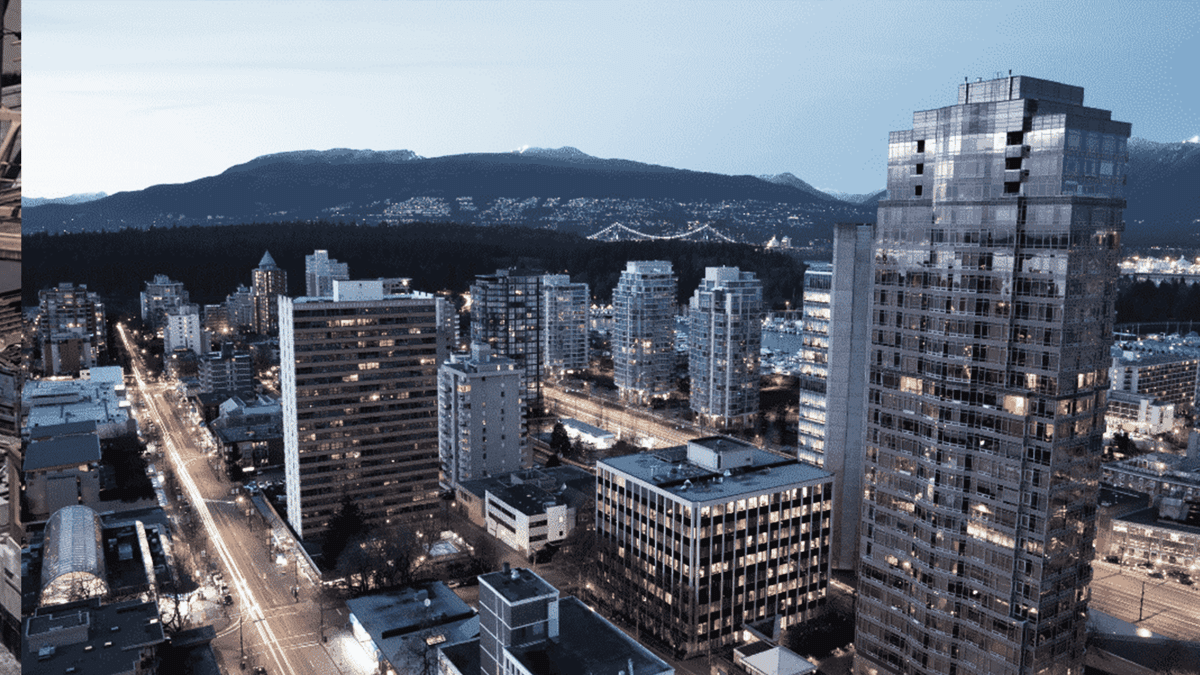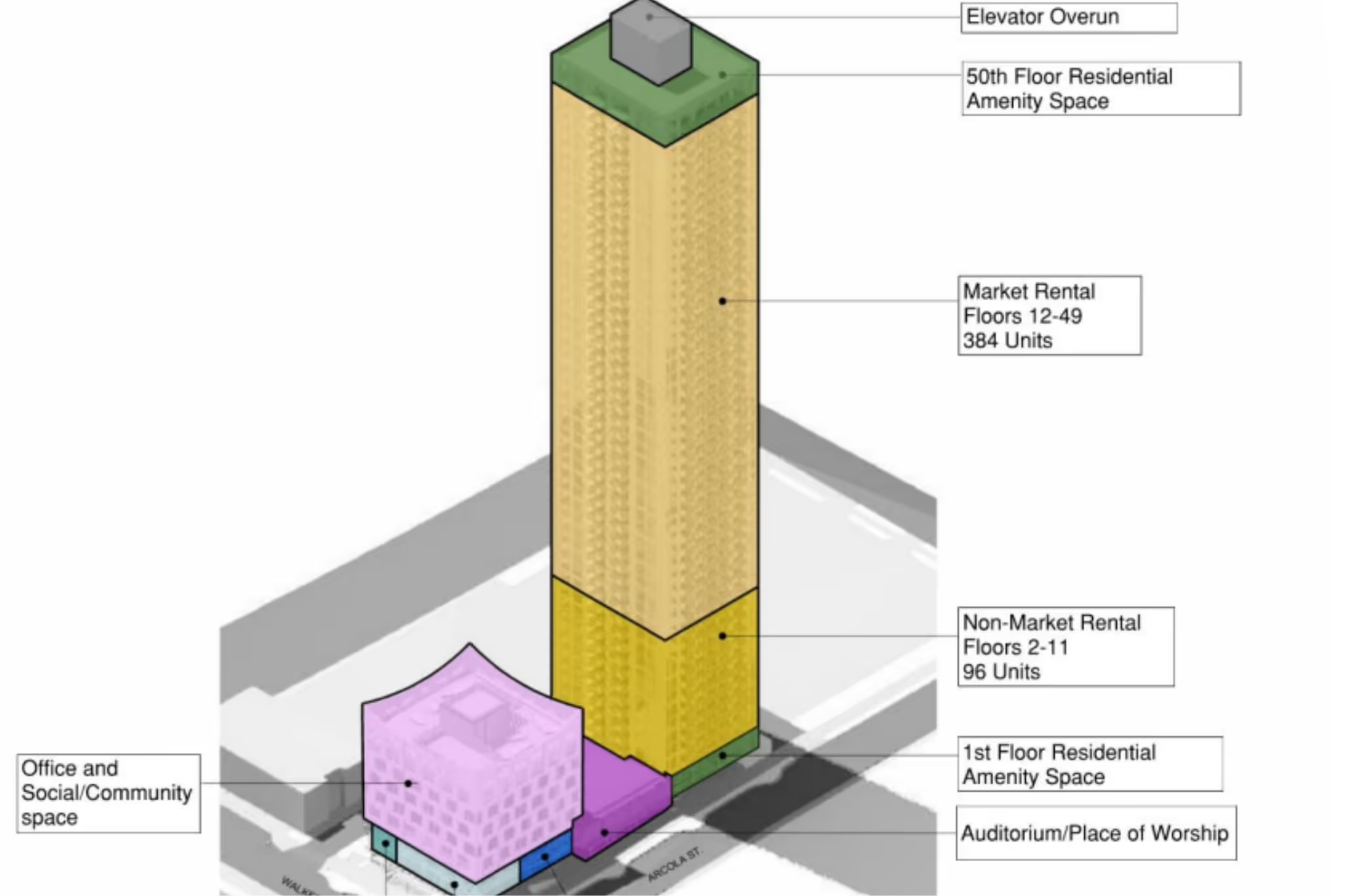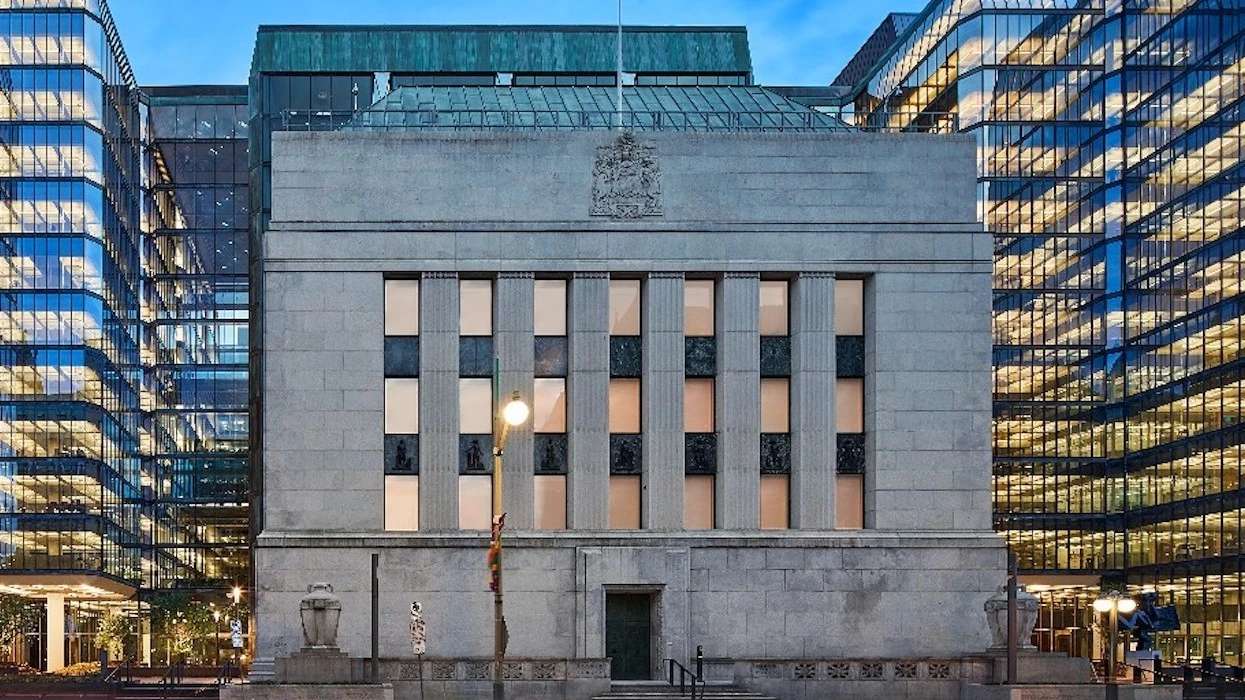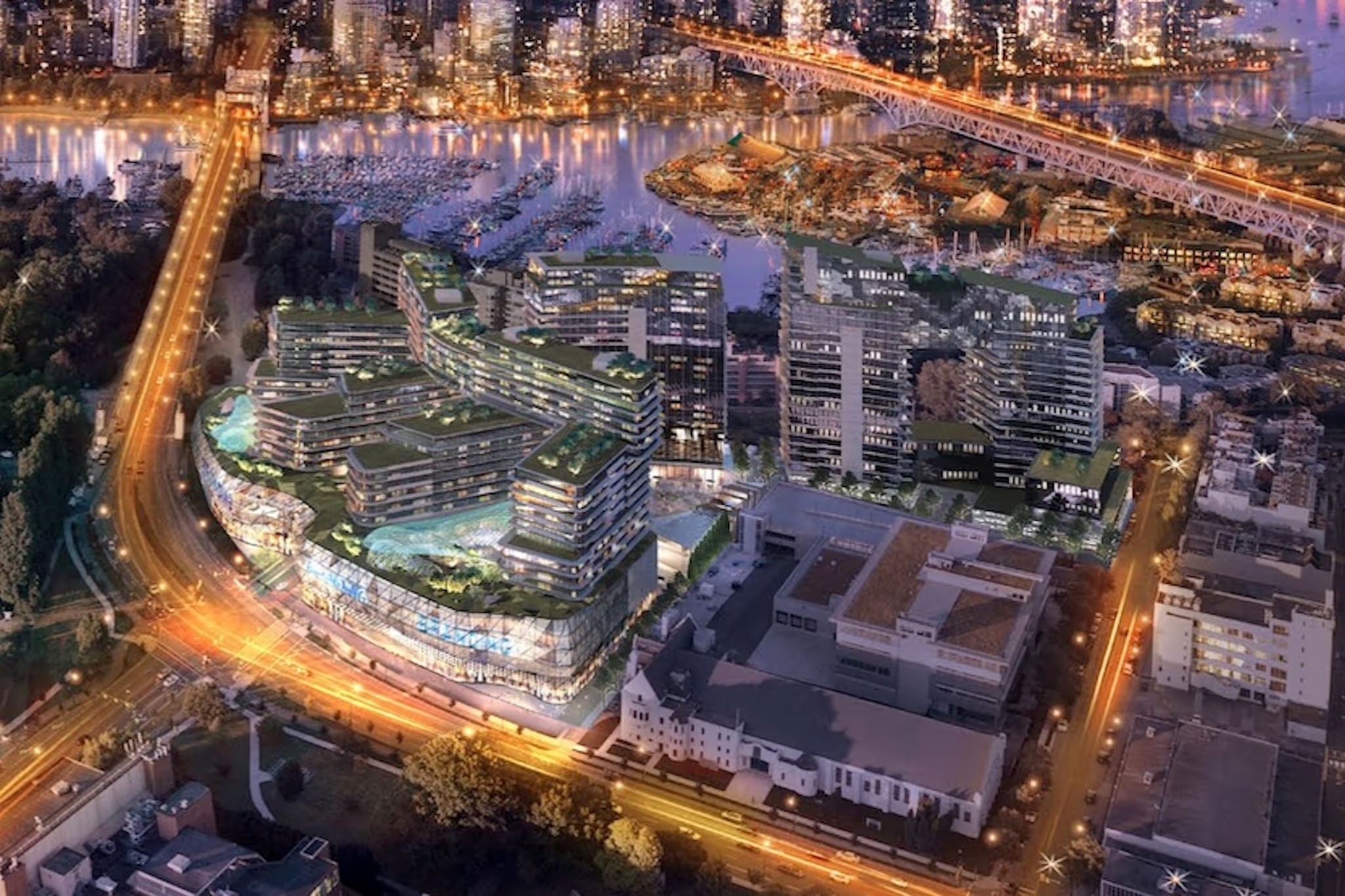A few additional key details about the massive Jericho Lands development emerged last week during a public hearing with Vancouver City Council on the proposed Official Development Plan (ODP) to support the project.
City Council finished listening to roughly 70 public speakers just before midnight, with the decision on formally turning the content of the January 2024-approved Policy Statement for the project into an ODP deferred until April 22.
Before public speakers were heard, Brennan Cook — vice president of MST Development Corporation, the real estate company wholly owned by the Musqueam, Squamish, and Tsleil-Waututh First Nations — shared that construction on the first 4,000 homes could begin in 2028. The 90-acre site in the West Point Grey neighbourhood is jointly owned by MST and the federal Crown corporation Canada Lands Company.
The first phase represents approximately 31 per cent of the total 13,000 homes planned for the site, which will be built over four phases. This initial phase is located on the western end of the site, with subsequent phases generally progressing from west to east.
Following the approval of the ODP, MST Development would move forward with rezoning, development permit, and building permit applications for the first phase. If all goes according to plan, Cook said the first buildings could be completed in about seven years — by 2032.
Matt Shillito, the City of Vancouver’s director of special projects, noted that the first phase is proceeding independently of SkyTrain’s Millennium Line extension to the University of British Columbia (UBC) from Arbutus. The extension would provide two stations serving the Jericho Lands — one station located within the western half of the site, and Alma Station (at the intersection of Alma Street and West Broadway) just east of the site.
Behind the scenes, detailed design and technical planning for the SkyTrain extension are well underway. As recently reported by Daily Hive Urbanized, the provincial government’s contractors completed drilling boreholes in December 2024 at roughly 100-metre intervals along the entire seven-kilometre route from Arbutus to UBC. The soil samples collected are being used for geotechnical analysis to inform the project’s engineering design and overall business case.
No timeline has been established to finish the business case work to support the project, but the January 2025 mandate letter by Premier David Eby to Mike Farnworth, the B.C. Minister of Transportation and Transit, specifically included the key direction to lead the work to advance progress on the UBC SkyTrain extension. If all goes as planned with securing funding and approvals, construction on the extension could begin in the early 2030s, based on TransLink’s 10-year vision.
June 2023 revised concept of the Jericho Lands. (MST Development Corporation/Canada Lands Company)
June 2023 revised concept of the Jericho Lands. (MST Development Corporation/Canada Lands Company)
During the City’s earlier Policy Statement planning process, it was indicated that the permitted density and land uses and the transportation infrastructure strategy for the Jericho Lands would need to be revisited if the SkyTrain extension does not move forward. At last week’s public hearing, Cook and Shillito reaffirmed that position.
Cook shared that under the unlikely scenario that the UBC SkyTrain does not proceed, they would change their road and parking requirements, and work with TransLink and the provincial government to implement strategies such as enhanced bus routes.
“We have also put in place in both the Policy Statement and reflected them also in the Official Development Plan, a break for such that if we find that the UBCx process is substantially delayed beyond the end of phase one, then we would relook at the plan, including with public engagement. And we would come back to council with amendments as necessary,” said Shillito. He noted that construction on the first phase of the Jericho Lands is expected to take about eight years, which would put completion at around 2036.
“We are certainly hopeful and confident that the UBCx planning will move along in parallel with that and we’ll be able to move forward in parallel,” continued Shillito.
Shillito added that the Jericho Lands is “the largest single site on the proposed UBCx extension, and I think one would say that the proposal kind of anchors and catalyzes the UBCx extension. Now, there is a strong business case for the UBCx extension beyond this project, but this project certainly is an important part of it.”
$30,000 downpayment for a home, and 35% wood-frame and mass-timber buildings
Upon full buildout, the Jericho Lands will have a mix of low-, mid-, and high-rise buildings, including dozens of towers reaching up to 49 storeys.
There will be about 13.6 million sq. ft. of total building floor area — containing 12.6 million sq. ft. of residential uses and at least 500,000 sq. ft. of commercial uses. This translates into about 13,000 new homes for up to approximately 24,000 residents and employment spaces for about 3,000 jobs.
Cook noted that beyond the first phase, the timeline for completing the remaining three phases is uncertain — potentially extending the overall buildout of all four phases beyond 25 years. He emphasized that the pace of development will depend not only on market demand but also on the delivery of major utilities and supporting infrastructure, including but not limited to the SkyTrain extension.
December 2023 conceptual artistic rendering of the Jericho Lands. (MST Development Corporation/Canada Lands Company)
December 2023 master plan of the Jericho Lands. (City of Vancouver)
Phasing plan for the Jericho Lands redevelopment. (MST Development Corporation/Canada Lands Company)
David Negrin, the CEO of MST Development, and a previous longtime executive of Concord Pacific and Aquilini Development, noted the project will provide 3,500 units of “attainable” ownership housing, suggesting there will be home prices as low as $30,000 for a five per cent downpayment on a 750 sq. ft. unit priced at $600,000. This is 40 per cent lower than the $1 million market cost in other projects elsewhere in the city.
He says the mortgage will be equal to or less to the average market rent.
Altogether, these 3,500 attainable ownership housing units will account for three million sq. ft. of building floor area.
But there is a caveat: As outlined during the earlier Policy Statement planning process, the only form of ownership housing at the Jericho Lands will be strata leasehold. Unlike conventional freehold properties, strata leasehold provides ownership of the unit and a share of common areas — but not the land itself. These leases are also time-limited, typically lasting 99 years. Strata leasehold is expected to be the primary housing tenure type at the Jericho Lands.
This approach enables the First Nations owners of the project to retain ownership of the land in perpetuity.
Mirroring the Policy Statement, the ODP will also require at least 20 per cent of the Jericho Lands’ residential floor area be used for social housing, which translates into about 2,600 units. As well, at least 10 per cent of the residential floor area must be used for secured purpose-built market and below-market rental housing, with below-market rental housing accounting for a minimum of 25 per cent of the overall secured purpose-built rental housing component.
From the outset, it was also previously noted that the full scope of the social housing component is only possible if the federal and/or provincial governments provide funding. Without funding from the senior governments, according to City staff, it is expected the project will be able to achieve about 16 per cent of the required social housing — approximately 2,000 social housing units.
Negrin highlighted that the project’s substantial secured purpose-built rental housing component could be especially beneficial for UBC students, offering attainable rental options near campus — further enhanced by the convenience of the SkyTrain extension.
Overall, much of the project is geared to meet the needs of middle-income individuals and households.
December 2023 conceptual artistic rendering of the Jericho Lands. (MST Development Corporation/Canada Lands Company)
When it comes to the building construction typology, Negrin shared that 35 per cent of the buildings at the Jericho Lands will have wood-frame or mass-timber construction. In 2024, following the provincial government’s policies, the City of Vancouver increased the permitted height of mass-timber buildings to up to 18 storeys. Negrin noted that 50 per cent of the homes will be within buildings under 18 storeys.
“So 35% is mass timber and timber, never been done in a large project in Vancouver,” emphasized Negrin.
A new replacement home for West Point Grey Academy
There has been some uncertainty over the future of West Point Grey Academy (WPGA) — an independent elementary and secondary school from Kindergarten to Grade 12. With an enrolment of about 1,000 students, it accounts for a sizeable portion of Vancouver’s overall mix of public, independent, and private school capacity.
WPGA’s sprawling campus is located within the west side of the Jericho Lands. Since 1996, it has been situated within 1960s-built buildings that were previously used as a school for the deaf.
Cook says they are in “regular communication” and have a “very good relationship” with WPGA.
“They were tenants, existing tenants, when the nations purchased the land almost 10 years ago. And we are working towards finding a home in the new development. We’ve been meeting with them, I don’t want to say quarterly, but certainly a couple of times a year to provide updates and express our appreciation of their partnership, but also to ask them to help find solutions that benefit both the nations and the school. So it obviously won’t be in the same format,” said Cook, who noted that the First Nations perceive WPGA as a “commercial tenant.”
However, during deliberations, ABC councillors Lisa Dominato and Sarah Kirby-Yung noted that WPGA had informed City Council of its request for a “community facility” designation rather than the “commercial” designation proposed by MST Development under the ODP. They also emphasized that WPGA is a registered non-profit organization.
“They’re looking for a community facility designation and they stipulate for, to ensure that spaces remain accessible and available for public and educational benefit,” said Dominato.
The difference in designation also likely impacts the rent WPGA could be required to pay.
In response, Cook said until the ODP is created to provide improved certainty, “it’s really hard for us to guarantee or satisfy West Point Grey Academy of their ongoing tenure… The intent is there, but this is one of those things that the ODP allows us — that certainty [and] security to do the appropriate planning over the next couple of years, while we figure out how the lands are gonna be developed, [and] who’s gonna be incorporated in which sites.”
City staff then shared that it is within City Council’s ability to amend the draft ODP to designate WPGA as a community facility. This could also be performed during the future rezoning application.
Without this community facility designation, City staff note that the ODP, with the proposed commercial designation, serves as “enabling rather than requiring with respect to the academy.”
December 2023 conceptual artistic rendering of the Jericho Lands. (City of Vancouver)
Additionally, as previously included in the Policy Statement, the ODP requires air space be set aside for a future new additional public elementary school operated by Vancouver School Board for up to 550 students. With a minimum building floor area of 54,000 sq. ft., it could be co-located with other community amenities and/or affordable housing.
In total, the Jericho Lands will provide $1.3 billion worth of public benefits and infrastructure, including childcare for 259 young kids, after-school care for 240 kids, 30 acres of public parks and open spaces, a 15,000 sq. ft. arts and cultural space, a non-traditional Indigenous learning library, a 50,000 sq. ft. community centre, an expansion of a local fire station, and various street-related upgrades. The aforementioned social housing component accounts for half of this value.
An ODP for a master-planned, neighbourhood-sized development is not a municipal planning requirement, but this is being adopted to turn the policy statement’s approved development allowances, affordable housing, and public benefit requirements into a City bylaw. This effectively provides more certainty than the policy statement, serving the purpose of supporting the efforts of the First Nations in securing financing from borrowers to allow the project to move toward construction.
MST Development and Canada Lands Company are also working together on the Heather Lands redevelopment on the Cambie Corridor in Vancouver.
by Kenneth Chan| Apr 20 2025, 12:32 pm
source: dailyhive.com
link: https://dailyhive.com/vancouver/jericho-lands-vancouver-development-timeline

































